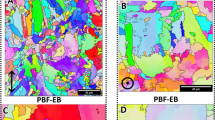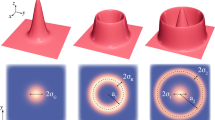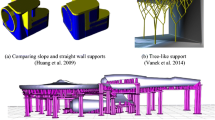Abstract
In this paper, a parallelized 3D cellular automaton computational model is developed to predict grain morphology for solidification of metal during the additive manufacturing process. Solidification phenomena are characterized by highly localized events, such as the nucleation and growth of multiple grains. As a result, parallelization requires careful treatment of load balancing between processors as well as interprocess communication in order to maintain a high parallel efficiency. We give a detailed summary of the formulation of the model, as well as a description of the communication strategies implemented to ensure parallel efficiency. Scaling tests on a representative problem with about half a billion cells demonstrate parallel efficiency of more than 80% on 8 processors and around 50% on 64; loss of efficiency is attributable to load imbalance due to near-surface grain nucleation in this test problem. The model is further demonstrated through an additive manufacturing simulation with resulting grain structures showing reasonable agreement with those observed in experiments.















Similar content being viewed by others
References
Acharya R, Sharon JA, Staroselsky A (2017) Prediction of microstructure in laser powder bed fusion process. Acta Mater 124:360–371
Antonysamy AA, Meyer J, Prangnell PB (2013) Effect of build geometry on the \(\beta \)-grain structure and texture in additive manufacture of Ti–6Al–4V by selective electron beam melting. Mater Charact 84:153–168
Al-Bermani SS, Blackmore ML, Zhang W, Todd I (2010) The origin of microstructural diversity, texture, and mechanical properties in electron beam melted Ti–6Al–4V. Metall Mater Trans A 41(13):3422–3434
Boettinger WJ, Warren JA, Beckermann C, Karma A (2002) Phase-field simulation of solidification. Ann Rev Mater Res 32(1):163–194
Carozzani T, Gandin C-A, Digonnet H, Bellet M, Zaidat K, Fautrelle Y (2013) Direct simulation of a solidification benchmark experiment. Metall Mater Trans A Phys Metall Mater Sci 44(2):873–887
Dantzig JA, Rappaz M (2016) Solidification. EPFL Press, Lausanne
Dezfoli ARA, Hwang W-S, Huang W-C, Tsai T-W (2017) Determination and controlling of grain structure of metals after laser incidence: theoretical approach. Sci Rep 7(41527):1–11
Ferreira AF, da Silva AJ, de Castro JA (2006) Simulation of the solidification of pure nickel via the phase-field method. Mater Res 9(4):349–356
Gandin C-A, Rappaz M (1994) A coupled finite element cellular automaton model for the prediction of dentritic grain structures in solidification processes. Acta Metall Mater 42(7):2233–2246
Gandin C-A, Desbiolles J-L, Rappaz M, Thevoz P (1999) A three-dimensional cellular automation-finite element model for the prediction of solidification grain structures. Metall Mater Trans A 30(12):3153–3165
Gandin C-A, Rappaz M (1997) A 3D cellular automaton algorithm for the prediction of dendritic grain growth. Acta Mater 45(5):2187–2195
Kim Y-T, Goldenfeld N, Dantzig J (2000) Computation of dendritic microstructures using a level set method. Phys Rev E 62(2):2471–2474
Kurz W, Giovanola B, Trivedi R (1986) Theory of microstructural development during rapid solidification. Acta Metall 34(5):823–830
Lipton J, Glicksman ME, Kurz W (1984) Dendritic growth into undercooled alloy melts. Mater Sci Eng 65:57–63
Liu DR, Reinhart G, Mangelinck-Noel N, Gandin C-A, Nguyen-Thi H, Billia B (2014) Coupled cellular automaton (CA)–finite element (FE) modeling of directional solidification of Al-3.5 wt% Ni alloy: a comparison with X-ray synchrotron observations. ISIJ Int 54(2):392–400
(2015) MPI: a message-passing interface standard. Version 3.1. http://mpi-forum.org/docs/mpi-3.1/mpi31-report.pdf
Panwisawas C, Qiu C, Anderson MJ, Sovani Y, Turner RP, Attallah MM, Brooks JW, Basoalto HC (2017) Mesoscale modelling of selective laser melting: thermal fluid dynamics and microstructural evolution. Comput Mater Sci 126:479–490
Rappaz M, Gandin C-A (1993) Probabilistic modelling of microstructure formation in solidification processes. Acta Metall Mater 41(2):345–360
Rodgers TM, Madison JD, Tikare V, Maguire MC (2016) Predicting mesoscale microstructural evolution in electron beam welding. JOM 68(5):1419–1426
Rodgers TM, Madison JD, Tikare V (2017) Simulation of metal additive manufacturing microstructures using kinetic Monte Carlo. Comput Mater Sci 135:78–89
Scott TJ, Beaulieu TJ, Rothrock GD, O’Connor AC (2016) Economic analysis of technology infrastructure needs for advanced manufacturing: additive manufacturing. In: NIST GCR-16-006, NIST, Gaithersburg, MD
Tan L, Zabaras N (2007) A level set simulation of dendritic solidification of multi-component alloys. J Comput Phys 221(1):9–40
Wheeler AA, McFadden GB, Boettinger WJ (1996) Phase-field model for solidification of a eutectic alloy. In: Proceedings of the Royal Society of London A: Mathematical, Physical and Engineering Sciences, vol 452, no 1946. The Royal Society, pp 495–525
Yan W, Ge W, Qian Y, Lin S, Zhou B, Liu WK, Lin F, Wagner GJ (2017) Multi-physics modeling of single/multiple-track defect mechanisms in electron beam selective melting. Acta Mater 134:324–333
Yin H, Felicelli SD (2010) Dendrite growth simulation during solidification in the LENS process. Acta Mater 58(4):1455–1465
Zhang J, Liou F, Seufzer W, Taminger K (2016) A coupled finite element cellular automaton model to predict thermal history and grain morphology of Ti–6Al–4V during direct metal deposition (DMD). Addit Manuf 11:32–39
Zhao C, Fezzaa K, Cunningham RW, Wen H, Carlo FD, Chen L, Rollett AD, Sun T (2017) Real-time monitoring of laser powder bed fusion process using high-speed X-ray imaging and diffraction. Sci Rep 7(3601):1–11
Zinoviev A, Zinovieva O, Ploshikhin V, Romanova V, Balokhonov R (2016) Evolution of grain structure during laser additive manufacturing. Simulation by a cellular automata method. Mater Des 106:321–329
Acknowledgements
Gregory J. Wagner and Wing Kam Liu acknowledge the support by the National Science Foundation (NSF) Cyber-Physical Systems (CPS) under Grant No. 359 CPS/CMMI-1646592. Yanping Lian, Wentao Yan, and Wing Kam Liu acknowledge the support by Center for Hierarchical Materials Design (CHiMaD) under Grant No. 70NANB14H012. Stephen Lin acknowledges the support by the NSF Graduate Research Fellowship under Grant No. DGE-1324585.
Author information
Authors and Affiliations
Corresponding author
Rights and permissions
About this article
Cite this article
Lian, Y., Lin, S., Yan, W. et al. A parallelized three-dimensional cellular automaton model for grain growth during additive manufacturing. Comput Mech 61, 543–558 (2018). https://doi.org/10.1007/s00466-017-1535-8
Received:
Accepted:
Published:
Issue Date:
DOI: https://doi.org/10.1007/s00466-017-1535-8




